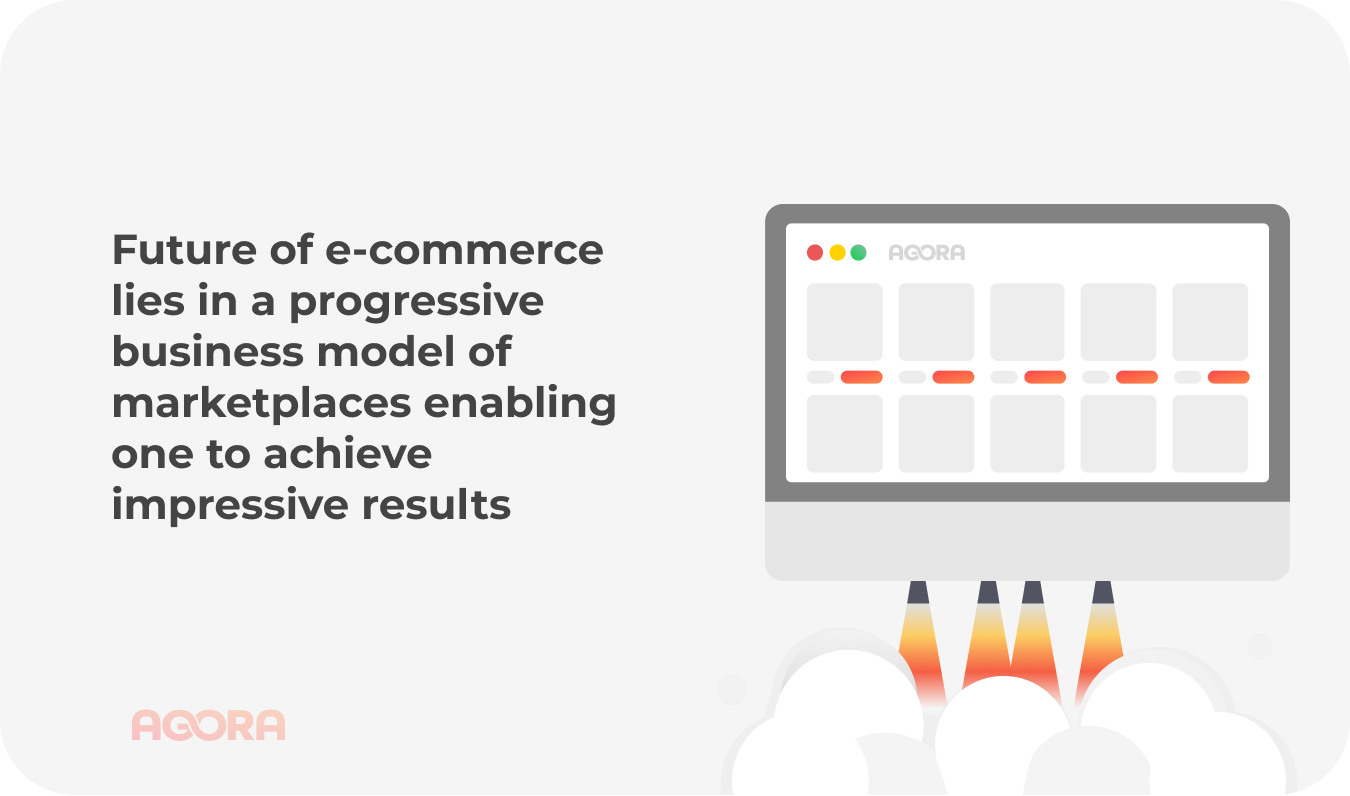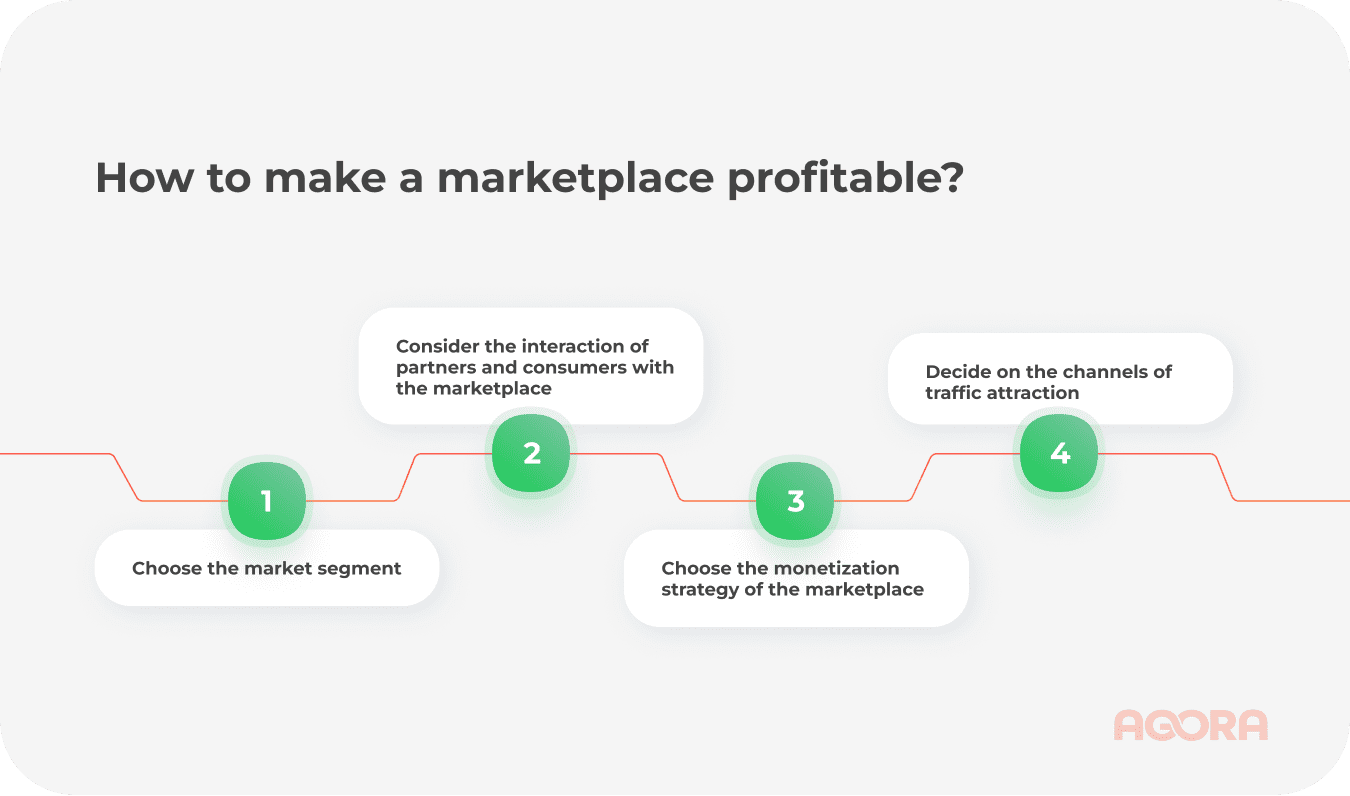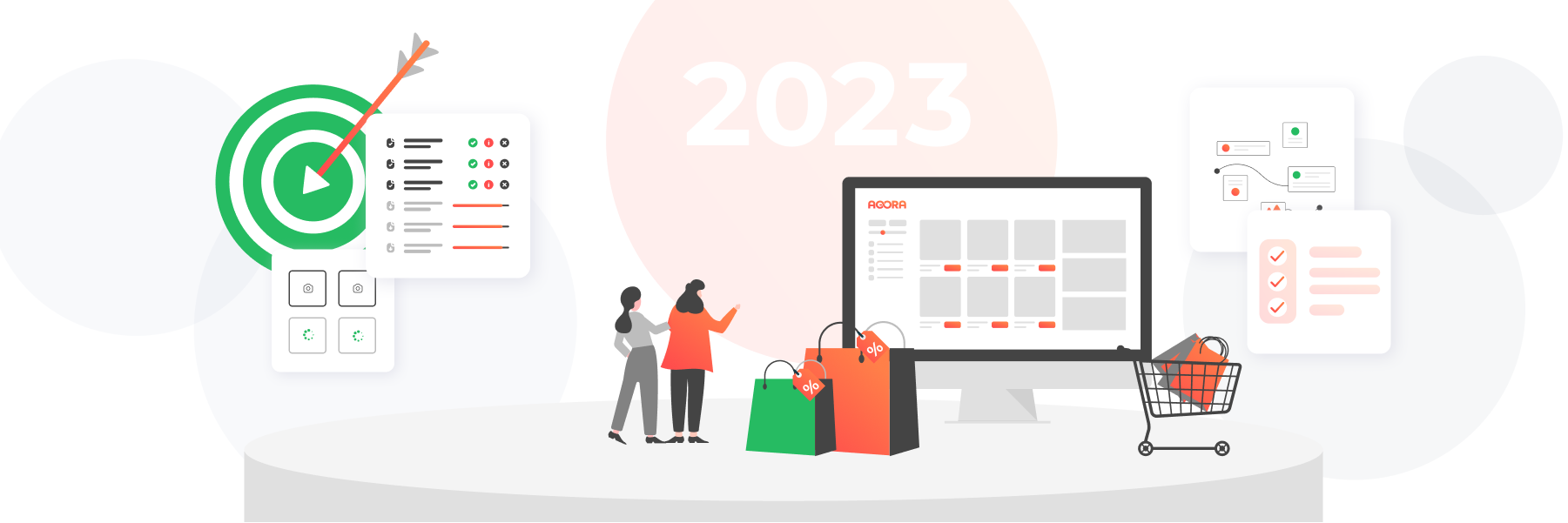
How to create a B2C marketplace: launch steps
Marketplaces are a key driver of the e-commerce market growth. This article covers the e-commerce trends and the aspects which need to be taken into account while launching your own marketplace so as to avoid making mistakes.
Article content:
➩ Briefly about marketplaces and advantages for their owners, suppliers and buyers
➩ Forecasts for B2C marketplace development in 2023-2024 and why this model is so popular
➩ Development of your own marketplace: launch steps
➩ Turnkey B2C trading platform (marketplace) based on AGORAB2B platform
Briefly about marketplaces and advantages for their owners, suppliers and buyers
B2C marketplace is an electronic commerce online platform where various sellers offer retail products and services to end customers, who are individuals. Marketplaces connect thousands of suppliers and buyers within a single platform. This business model provides both owners, suppliers and customers with benefits, that is why it is so popular.
- For sellers, the main advantages are having a well-established customer base, tools for the promotion of goods, a relatively simple process of bringing products to the market, increasing check averages and turnover and expanding the geography of sales.
- For buyers, a marketplace is above all a platform with wide stock. Apart from this, it is also easier to choose and compare characteristics and prices of items on a marketplace.
- For owners, there are illimited opportunities for sales digitalization (in the case of developing a marketplace for selling your own range of products and services), attracting other businesses and investors (thus creating multi vendor platforms).

However, there are still disadvantages of general-purpose marketplaces worth considering. If a company does consider all shortcomings, it might avoid difficulties in the very beginning and additionally use other business tools.
- Multi vendor marketplaces adapt worse to a single product category, these platforms always have leading categories and categories falling behind. For instance, small objects of everyday use are sold in a completely different manner than, let’s say, furniture or electronics.
- High competition due to the low threshold for brands to enter a marketplace continues to grow.
- Difficulties in attracting target audience to your products.
- Consumer’s confidence in new market actors is still lacking.
- Conditions are tightening: there is a growth in commissions for suppliers, increase in delivery prices and terms up to the introduction of payments for acceptance of goods or even registration of new suppliers.
- Little communication with buyers. A marketplace focuses on promoting products and services instead of brand values and seller’s personality.
Nevertheless, marketplaces do offer wide technical and analytical opportunities for business development. We also shouldn’t forget about omnichannel retailing (in other words, being and communicating with a consumer through all sales channels), which is an e-commerce trend that will last. Thus, the shortcomings of one platform are offset by the advantages of another.
Forecasts for B2C marketplace development in 2023-2024 and why this model is so popular
Consumers’ behavior is changing due to the global crisis and new marketplace trends are emerging. E-commerce market sees reorientation of consumer product preferences. However, even in this situation there is a steady increase in orders. Furthermore, there is a period of high sales from January to March 2023. Thus, there is no doubt about the success of marketplaces, since such a platform:
- builds up its ecosystem, opens new distribution centers, pick-up points, offers promotions on a regular basis - all of it reduces final product prices which is especially relevant for users;
- offers fulfillment services, product matching, billing, concessional loans, internal advertising, an EDI module providing significant growth opportunities to suppliers. Besides, marketplaces aim at developing additional services, such as traveling and banking. A single platform replaces hundreds of shops and services, which is convenient and beneficial for buyers.
- implements automatization and processes acceleration. For instance, PIM systems allow one to effectively manage the ever-growing number of product cards during the process of uploading and processing product content (for one large marketplace, the number of goods can reach hundreds of millions of SKU). No marketplace will be able to operate without a PIM module in the coming years. The wider the geography of presence of marketplaces and the faster the development of such platforms are, the more suppliers will come to these platforms and the more product cards there will be. Therefore, the demand for PIM systems will increase.
According to experts, the future of electronic commerce lies in a new and progressive business model of marketplaces enabling one to achieve impressive results. However, it is difficult to compete with giant marketplaces. And is it even worth it? The e-commerce market allows one not only to fulfill one’s potential as a large vendor of a marketplace, but also to create a niche marketplace one’s own production then increase the turnover while attracting new suppliers.

Such a trend for specialized marketplaces is gaining momentum. For instance, product, service, investment, industrial, information and logistics online platforms are now more beneficial when working on projects. At the same time, highly specialized marketplaces do not waste recourses on the competition with the leaders and focus on a specific segment of the target audience. Besides, they demonstrate great expertise and service and they eventually get loyal customers. Attracting this audience, instead of customers with varied interests, is easier and more beneficial economically.
AGORAB2B has been implementing B2C and B2B marketplaces and developing complex enterprise projects for more than 10 years. Our company will help you promptly enter the market due to the launch of an out-of-the-box MVP (which takes from 2-3 months), occupy the niche and complete the creation of a marketplace of any functionality.
Development of your own marketplace: launch steps
The implementation of one’s own marketplace always has a positive impact on the company’s capitalization and brings related business benefits. For example, the transformation of an online store into a marketplace provides additional opportunities for increasing income and scaling up one’s business. However, developing and opening a marketplace is more difficult than creating an online store, as a marketplace consists of a complex architecture, users’ strategies and a lot of integrations. When the creation of a marketplace is needed, it is highly important to choose a reliable and experienced developer, as well as an approach which will simplify the process instead of making it even more complex.

Marketplaces can be created from scratch, efficiently substitute a simple online store or expand a franchise network platform. In any case, there are compulsory launch steps to be taken before starting to use a marketplace. Our experts recommend splitting the work into steps instead of plunging in implementation of large-scale business ideas.
It is better to begin with the analysis of the niche, market, competitors, opportunities and demand, and to determine the type of marketplace and its monetization model.
The foundation of a successful b2c marketplace is analytics and business hypothesis test. Even with the most brilliant idea that one may be absolutely sure of, if the marketplace doesn’t cover the needs of buyers, doesn’t have a unique trade offer and doesn’t stand out against a background of competitors, the following steps and implementation may not even be needed.
How to turn a marketplace into a profitable B2C platform? At first, one should decide:
- what market segment to work with, how partners and buyers will interact with the platform, what tasks the marketplace will solve.
- what strategy of monetization to use. Marketplaces tend to use commissions and payments for leads, subscriptions, promotions to the top, freemium (providing additional advertising services, special offers, loans, subscriptions pro, etc.), placement fees. Different monetization options may be used together.
- what channels of traffic attraction to use (direct, organic, referral channels, social networks, email newsletters, etc.), which one will be effective for one’s tasks. Then one should establish a budget for promotion.

Quite an important step before launching an MVP is to choose the developer and the way of creating your marketplace: custom marketplace development from scratch or based on a ready-made solution, with price and time required for development depending on the choice. In the first case, the client gets a business solution which takes all details, processes and task into account, but it may take years to develop and cost way more than the second option. The second one is faster (from 2-4 months) and less expensive. Moreover, solutions out-of-the-box also have the customization option. For instance, the AGORAB2B platform has more than 200 connected business modules that the customer may use for his or her purposes and tasks. This basic version may be modified later on, with new business options added, and can be scaled up easily.
The second step is to configure and launch an MVP
In order to avoid common mistakes when developing a b2c marketplace, one may spend up to a year developing a solution that will take all customer’s wishes into consideration, but it is better to start with an MVP, a minimum viable version of one’s product. Many experts express concerns that such an approach may lead to difficulties with further scaling. This is not a problem in the case of the AGORAB2B high load platform which is capable of withstanding high loads and provides for further accelerated scaling.
Out-of-the-box MVP solutions based on the AGORAB2B platform reduce the period of business materialization from idea to first profit with minimal investment. Before developing every project, the AGORAB2B team always conducts preliminary internal analysis. AGORAB2B creates b2c and b2b marketplaces that are ready for scaling and high loads with no changes in their architecture and technologies even at the stage of the out-of-the-box project. For this purpose, the “box” has such tools, as a catalog with Elastic, data bus for processing suppliers’ data, figures monitoring at the design and using stages. And even before the realization of the project, the team understands when to add new server capacities for the marketplace to withstand almost any loads (up to 20-30 thousand users, more than 20 million SKU and system response of 0,5 seconds).

The third step: testing with customers, modification and use
More than 500 successful cases in the development of online platforms, hundreds of launched marketplaces and expertise in e-commerce projects allows our company to see all pitfalls and offer tested solutions which take into account all common mistakes of existing marketplaces. Nevertheless, the main thing after having developed an MVP is to know when to stop while developing, internal testing and launch a test among users in the real market.
In any case, technical and content modifications are inevitable after launching the project, it is a cyclical process. With the help of first real users / suppliers, the owners of the marketplace get feedback and can focus on the improvements of the basic functionality. For instance, it allows owner to understand whether navigation and design elements are suitable, whether they help to complete the target action, whether all buttons function, etc.
At this stage, it is also important to pay even more attention to competent promotion and marketing. Thus, it is necessary to first think over a marketing strategy in order to attract enough suppliers, then attract buyers.
A marketplace is a complex high load project that requires hard work which can become easier if a professional team is involved.

Turnkey B2C trading platform (marketplace) based on AGORAB2B platform
The B2C marketplace development based on the AGORAB2B platform is the first step to:
- quick digitalization of an offline business;
- the increase in sales and bringing them to a new level;
- capitalization of the company and expansion of market influence.
What does the company-customer get by opting for a solution based on the AGORAB2B platform?
- Rapid launch and start of work, flexible development with the constructor principle. The initial version has enough modules to start with flexible options of modification and configuration.
- Affordable price of development with a SaaS subscription, or purchase of a boxed On-Premise license.
- Low code technologies allowing one to independently modify the marketplace without involving the development staff.
- Openness: the solution can be integrated with ERP, CRM and logistics systems.
- Digitalization of sales due to well-designed billing, adjustable product matching and detailed analytics.
- The option to create a unique design for your project or to use ready-made standard solutions.
- Onboarding: familiarizing new users, suppliers and clients with the product, personal account, assistance in downloading price lists.
- The opportunity to receive qualified technical support during and after completion of work.
The retail and e-commerce field is changing rapidly, that is why it is strategically more beneficial to choose quick and efficient solutions. The managers of our company AGORAB2B will help you find the best option for your business goals.
Also read


